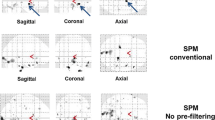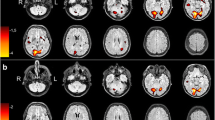Abstract.
An automated voxel-based analysis of brain images using statistical parametric mapping (SPM) is accepted as a standard approach in the analysis of activation studies in positron emission tomography and functional magnetic resonance imaging. This study aimed to investigate whether or not SPM would increase the diagnostic yield of ictal brain single-photon emission tomography (SPET) in temporal lobe epilepsy (TLE). Twenty-one patients (age 27.14±5.79 years) with temporal lobe epilepsy (right in 8, left in 13) who had a successful seizure outcome after surgery and nine normal subjects were included in the study. The data of ictal and interictal brain SPET of the patients and baseline SPET of the normal control group were analysed using SPM96 software. The t statistic SPM{t} was transformed to SPM{Z} with various thresholds of P<0.05, 0.005 and 0.001, and corrected extent threshold P value of 0.05. The SPM data were compared with the conventional ictal and interictal subtraction method. On group comparison, ictal SPET showed increased uptake within the epileptogenic mesial temporal lobe. On single case analysis, ictal SPET images correctly lateralized the epileptogenic temporal lobe in 18 cases, falsely lateralized it in one and failed to lateralize it in two as compared with the mean image of the normal group at a significance level of P<0.05. Comparing the individual ictal images with the corresponding interictal group, 15 patients were correctly lateralized, one was falsely lateralized and four were not lateralized. At significance levels of P<0.005 and P<0.001, correct lateralization of the epileptogenic temporal lobe was achieved in 15 and 13 patients, respectively, as compared with the normal group. On the other hand, when comparison was made with the corresponding interictal group, only 7 out of 21 patients were correctly lateralized at the threshold of P<0.005 and five at P<0.001. The result of the subtraction method was close to the single case analysis on SPM at P<0.05. However, at higher thresholds (P<0.005 and 0.001) the subtraction method was comparable to the SPM results only when individual ictal images were compared with the normal control group, and not when comparison was with the interictal group. It is concluded that SPM is an alternative diagnostic method for the localization or lateralization of the seizure focus in temporal lobe epilepsy and that interictal SPET could be omitted if a normal brain SPET database were to be established. The medical cost of seizure localization would thereby be reduced.
Similar content being viewed by others
Author information
Authors and Affiliations
Additional information
Received 27 April and in revised form 22 July 2000
Electronic Publication
Rights and permissions
About this article
Cite this article
Lee, J., Kim, HJ., Lee, B. et al. Evaluation of ictal brain SPET using statistical parametric mapping in temporal lobe epilepsy. Eur J Nucl Med 27, 1658–1665 (2000). https://doi.org/10.1007/s002590000364
Published:
Issue Date:
DOI: https://doi.org/10.1007/s002590000364




